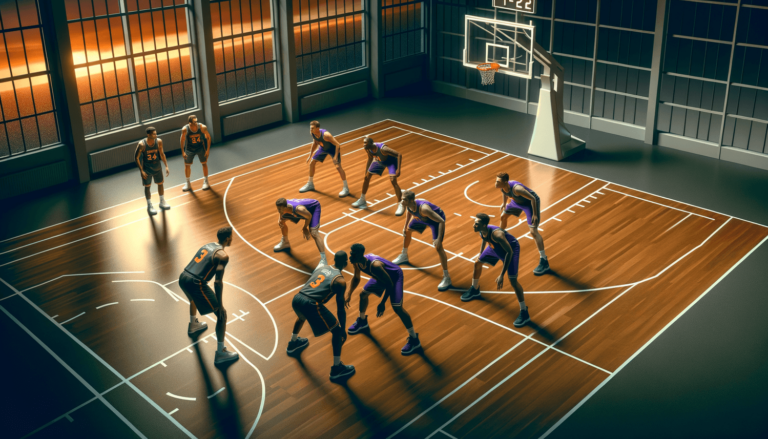
What’s a 1-2-2 Matchup Zone Defense in Basketball?
Written by: Basketball Universe
Last updated:

Ready to unravel the intriguing secrets of basketball defensive strategies? Buckle up, hoop enthusiasts, as we dive into the depths of the 1-2-2 Matchup Zone Defense, a game-changer in the world of basketball. By marrying the best aspects of man-to-man and zone defenses, this dynamic approach has the power to throw opponents off balance and give your team a stifling edge. Let’s embark on a thrilling journey exploring the ins and outs of the 1-2-2 Matchup Zone Defense, helping you unleash the ferocious potential of your team on the court. Game on!
What’s a 1-2-2 Matchup Zone Defense in Basketball?
A 1-2-2 Matchup Zone Defense in basketball is a hybrid defensive strategy that combines elements of man-to-man and zone defenses. The formation consists of one player at the top, two players in the middle, and two players near the baseline. Each defender is responsible for a specific area on the court but also matches up with an offensive player within that zone. This approach allows for greater defensive coverage, flexibility, and adaptability, making it harder for opponents to score and disrupting their offensive game plan.
Understanding the 1-2-2 Matchup Zone Defense
The 1-2-2 Matchup Zone Defense is a compelling approach to stifle your opponent’s offensive schemes in basketball. To fully appreciate its effectiveness and tactical advantages, let’s break down its fundamental concepts and key components.
Formation and Player Roles
In the 1-2-2 configuration, the court is divided into five zones, essentially forming a ‘W’ shape. One player is stationed at the top near the three-point line (usually the point guard), while two players (typically the wings) are positioned on the elbows or wings of the court. Finally, two players (usually the forwards or centers) cover the bottom corners close to the baseline. Each player is assigned a specific area of responsibility but must also be aware of their individual matchups:
- Top Defender (1): Responsible for defending the ball handler at the top of the key and preventing penetration to the paint.
- Wing Defenders (2 & 3): Tasked with covering the wings and denying passing lanes to cutters and shooters.
- Front/Corner Defenders (4 & 5): Charged with protecting the low post, preventing easy baskets, and boxing out for rebounds.
Hybrid Man-to-Man and Zone Principles
The real magic of the 1-2-2 Matchup Zone Defense lies in how it combines the man-to-man and zone defenses. Although each player is assigned a zone to protect, they also need to actively engage in man-to-man defense, moving with their assigned offensive player within their zone.
When the ball is passed or moves away from the defender’s area, the defender returns to their assigned zone, always ready to challenge the closest player looking to score. This constant switching of responsibilities makes the matchup zone difficult for an opposing team to penetrate because they’re never quite sure which defensive approach they’ll be facing.
Tactics and Adjustments
A key element to effectively executing the 1-2-2 Matchup Zone Defense is reading matchups and making adjustments as needed. Quick communication and trust between teammates are crucial to avoid leaving gaps and giving up easy scoring opportunities. Spotting mismatches before they lead to a potential disaster is essential. Some key tactics and adjustments to keep in mind include:
- Rotation: Timely and accurate rotation between defenders is essential in maintaining a cohesive formation and preventing easy baskets.
- Help Defense: A critical concept all players need to understand and practice is providing help defense when an opponent tries to penetrate the zone.
- Ball Pressure: Getting up close and personal with the ball handler makes it difficult for the opponent to see and execute their offense.
Why You Should Consider the 1-2-2 Matchup Zone Defense
Now that we have a good grasp of the mechanics involved in the 1-2-2 Matchup Zone Defense, let’s explore why this hybrid system is worth adding to your defensive arsenal.
Unpredictability
One of the primary advantages of the 1-2-2 Matchup Zone Defense is its ability to keep opponents guessing. Since it combines the best aspects of man-to-man and zone defenses, opponents can’t rely on a single offensive strategy to exploit openings or weaknesses. Expanding your team’s defensive playbook with the 1-2-2 Matchup Zone Defense is a great way to take your basketball prowess to new heights!
Flexibility and Adaptability
The 1-2-2 Matchup Zone Defense is renowned for its versatility, allowing for seamless adaptation to various offensive schemes. The ability to switch between man-to-man and zone concepts on the fly provides numerous tactical advantages, making it difficult for opponents to find a consistent rhythm throughout the game.
Limiting Easy Shots
By employing the 1-2-2 Matchup Zone Defense, your team can effectively cover passing angles, restrict easy baskets, and even force turnovers. This carefully orchestrated sequence of communication and rotation ensures that the opposing team is under constant pressure, often resulting in lower shooting percentages and less successful offensive plays.
Slowing Down the Tempo
More often than not, the 1-2-2 Matchup Zone Defense can slow down the opposing team’s transition game. When executed correctly, this defense forces your opponents to spend more time probing for gaps and mismatches before making their move. A slower tempo can throw high-paced, fast-scoring teams out of their comfort zone, giving your team an additional strategic advantage.
Fine-tuning the 1-2-2 Matchup Zone Defense
To make the most of this hybrid defense, consider these crucial tweaks and adjustments for smoother transitions, performance improvements, and quicker results on the court.
Communication
The success of any matchup zone is highly dependent on effective communication among teammates. From calling out screens, cutters, and switches to giving instant feedback on mismatches, keeping those lines of communication open is critical to maintaining a well-coordinated defense.
Rebounding
It’s no secret that one of the challenges of zone defenses is proper boxing out and securing rebounds. The 1-2-2 Matchup Zone Defense requires players to be alert and quick to react to rebounding opportunities. Consistent rebounding practice results in fewer second-chance points for your opponents and keeps your team in control of the game.
Pressure on the Ball
For the 1-2-2 Matchup Zone Defense to work effectively, the top player must consistently apply pressure on the ball handler. This helps obscure passing lanes and forces the ball handler to pick up their dribble, limiting their ability to get the ball to their teammates. Keep in mind that too much pressure might expose gaps if the ball handler gets past the top defender, so finding the right balance is key.
Help Defense
While in a 1-2-2 Matchup Zone Defense, it’s essential to know when to step in to provide help defense. Whether it’s closing in on a driving opponent or stopping a pass to the post, each player needs to be prepared to leave their designated zone momentarily to offer support to their teammates, then quickly recover their zone position.
Mastering the 1-2-2 Matchup Zone Defense with Practice Drills
Practice makes perfect! Here are some essential drills to help your team polish their skills and master the 1-2-2 Matchup Zone Defense.
Shell Drill
The shell drill is a staple when working on defensive strategies. This exercise helps players understand their responsibilities in the 1-2-2 Matchup Zone Defense while improving communication, footwork, and help defense readiness. While the offense moves the ball around the perimeter, the defense rotates and communicates, mapping out their roles and responsibilities within the matchup zone.
Closeout and Recovery Drill
This drill focuses on quickly closing out on shooters and recovering to their assigned zone. It begins with a pass from the top of the key to the wing, prompting the wing defender to close out on the shooter. As the wing defender recovers to their assigned zone, the ball is skipped to the opposite side, and the drill continues with the other wing defender closing out and recovering.
Defensive Adjustment Drills
Teaching players to effectively read and adjust to various offensive alignments is an invaluable skill. In this drill, defenders need to react to different offensive strategies and configurations quickly, learning how to adjust their defensive positions according to the matchups presented.
Conclusion
Adopting the 1-2-2 Matchup Zone Defense in basketball can bring a plethora of benefits to your team, such as increased unpredictability, flexibility, and adaptability. Incorporating this hybrid strategy into your game plan can make it challenging for opponents to find their offensive groove, positively impacting your team’s performance on the court. By mastering the subtle nuances of the 1-2-2 Matchup Zone Defense and dedicating time to practice, your team will be well on its way to dominating the competition!
Advanced Tips for the 1-2-2 Matchup Zone Defense
Now that we’ve comprehensively outlined the fundamentals of the 1-2-2 Matchup Zone Defense in basketball, let’s discuss some advanced tips that can further enhance your team’s performance and give you an edge on the court. These tips will help fine-tune your defensive execution, making it even more difficult for opponents to find their offensive footing.
Adjust to the Magic Diagonal
When playing against the 1-2-2 Matchup Zone Defense, some offenses may use the “Magic Diagonal” to create scoring opportunities. This diagonal stretches from the ball-side low post to the weak side wing, where the defense is at its most vulnerable. To account for these potential gaps, players need to understand when to anticipate this offensive tactic and make quick adjustments to cover all options.
Defending Against Screen and Roll Plays
As common as screen and roll plays are in basketball, defenses need to have a prepared response. When facing a screen in a 1-2-2 Matchup Zone Defense, players can either fight through the screen or switch with a nearby teammate. Swift communication and seamless rotations here are pivotal in preventing open lanes and unintended mismatches.
Sagging and Denying
In the 1-2-2 Matchup Zone Defense, a player should strategically sag off a weak shooter to clog the passing lanes and deter potential drives to the basket. Alternatively, when facing an exceptional shooter, that player should stick close, denying any comfortable shooting opportunities. Recognizing these threats and making the necessary adjustments can be the difference between giving up easy points and forcing the offense into a low-percentage shot.
1-2-2 Matchup Zone Defense Variations
While the 1-2-2 Matchup Zone Defense is a powerful strategy, you can also experiment with variations to keep the opposition guessing and suit your team’s specific strengths. Here are some popular alternatives and tweaks to consider.
1-3-1 Matchup Zone Defense
A 1-3-1 formation extends the defense further, often utilized to apply more pressure on a team’s perimeter shooters. It spreads the defenders into one player at the top, three across the middle, and one near the baseline – forming a more structured zone defense that can present unique challenges to an opposing offense.
3-2 Matchup Zone Defense
The 3-2 Matchup Zone Defense repositions the wing defenders close to the three-point line and the point guard closer to the basket. This shifts the focus primarily to defending the perimeter while still maintaining the flexibility of a matchup zone. The 3-2 variation can be particularly effective against offensive teams that rely heavily on outside shooting.
Hawk Defensive System
The Hawk Defensive System is an advanced approach that takes the 1-2-2 Matchup Zone Defense to a new level. It introduces more complex rotations and player movements, requiring excellent communication, high defensive IQ, and extensive practice. While this system demands more from your players, mastering the Hawk Defense can take your team’s defensive capabilities to new heights!
Preparing Your Offensive Strategy Against the 1-2-2 Matchup Zone Defense
As a basketball coach or player, it’s also essential to be prepared when facing the 1-2-2 Matchup Zone Defense. Here are some key techniques to adapt your offensive strategy and effectively counter this unique defensive setup.
Use Ball Movement to Shift the Defense
One proven tactic to exploit gaps in the 1-2-2 Matchup Zone Defense is rapid ball movement. Quick, precise passes can force the defense to alter their positions, creating seams to attack and catch defenders out of position for easy scoring opportunities.
Screen the Zone
Similar to man-to-man defenses, screening can be effective against matchup zones. Setting screens on the defenders can disrupt their rotation and create open looks for your offensive players, leading to higher-percentage scoring chances.
Attack the Seams
Despite its many advantages, the 1-2-2 Matchup Zone Defense is not without its weak points. To exploit these seams, encourage your offensive players to penetrate the gaps where defenders are stretched thin. Quick drives to the basket or well-timed cuts can result in high-percentage shots and put tremendous pressure on the defense.
By understanding and mastering the 1-2-2 Matchup Zone Defense, while also being prepared to
FAQs on the 1-2-2 Matchup Zone Defense
Ready to embark on your 1-2-2 Matchup Zone Defense journey, but still have some lingering questions? Fret not, we’ve compiled this handy FAQ section to address the most common queries associated with this defensive strategy. Equip yourself with this knowledge, and you’ll be primed to become a formidable force on the court.
1. What is the main advantage of using the 1-2-2 Matchup Zone Defense?
The primary advantage of the 1-2-2 Matchup Zone Defense lies in its unpredictability and adaptability. By blending elements of man-to-man and zone defenses, this strategy grants your team the flexibility to adapt to various offensive schemes, thereby giving opponents a challenging time finding their offensive rhythm.
2. How is the 1-2-2 Matchup Zone Defense different from a traditional 1-2-2 Zone Defense?
While both systems use the same player formation, the 1-2-2 Matchup Zone Defense combines man-to-man and zone defensive principles. In this hybrid approach, players are responsible for guarding specific areas while also matching up with offensive players within their zones, leading to a highly adaptable and dynamic defense.
3. Is the 1-2-2 Matchup Zone Defense suitable for all teams and skill levels?
Although the 1-2-2 Matchup Zone Defense is an effective option for many teams, its success largely depends on the team’s ability to communicate effectively and execute well-coordinated rotations. While adaptable for various skill levels, this defense can be more challenging to implement for inexperienced teams, which might struggle with communication and rapid decision-making.
4. Can the 1-2-2 Matchup Zone Defense be employed against fast-paced offenses?
Yes, the 1-2-2 Matchup Zone Defense can be effective against fast-paced offenses. When executed correctly, this approach can slow down the game tempo, forcing opponents to search for gaps and mismatches before making their offensive move, thus disrupting their preferred fast pace.
5. How do we deal with opponents using the Magic Diagonal against the 1-2-2 Matchup Zone?
When opponents use the Magic Diagonal, players need to be alert to anticipate this tactic and make quick adjustments. Coordination, communication, and understanding of defensive responsibilities are essential to minimize potential gaps and cover all offensive options.
6. Can the 1-2-2 Matchup Zone Defense be modified to deal with exceptional perimeter shooters?
Yes, you can adjust strategies within the 1-2-2 Matchup Zone Defense to handle perimeter shooters more effectively. By either positioning wing defenders higher or switching to the 3-2 Matchup Zone Defense, your team can prioritize perimeter defense and prevent outside shooters from receiving clean passes or open shots.
7. When should a team switch from a man-to-man defense to a 1-2-2 Matchup Zone?
A team might consider switching from a man-to-man defense to a 1-2-2 Matchup Zone when they want to add variety to their defense, need greater defensive adaptability, or plan to exploit an opponent’s weaknesses. Additionally, the 1-2-2 Matchup Zone Defense can be adopted based on specific scouting reports or in-game adjustments.
8. What other Matchup Zone Defense variations can a team use?
In addition to the 1-2-2 Matchup Zone Defense, teams can experiment with other variations, such as the 1-3-1 or 3-2 Matchup Zone Defenses, each bringing its unique set of advantages and defensive focuses. Understanding your team’s strengths and weaknesses, as well as your opponents’ offensive style, plays a critical role in selecting the best variation.
9. How can we maximize rebounding in a 1-2-2 Matchup Zone Defense?
Given the potential rebounding challenges with zone defenses, it’s crucial to prioritize boxing out and reacting quickly to rebound opportunities in the 1-2-2 Matchup Zone Defense. Encourage frontline players to assert their presence in the paint, while perimeter players swiftly crash the boards and secure possession.
10. Why is communication crucial in the 1-2-2 Matchup Zone Defense?
Effective communication is vital to maintaining a cohesive and consistent 1-2-2 Matchup Zone Defense. With continuous communication, defenders can rapidly call out
Featured Posts
- No pillar pages found.





